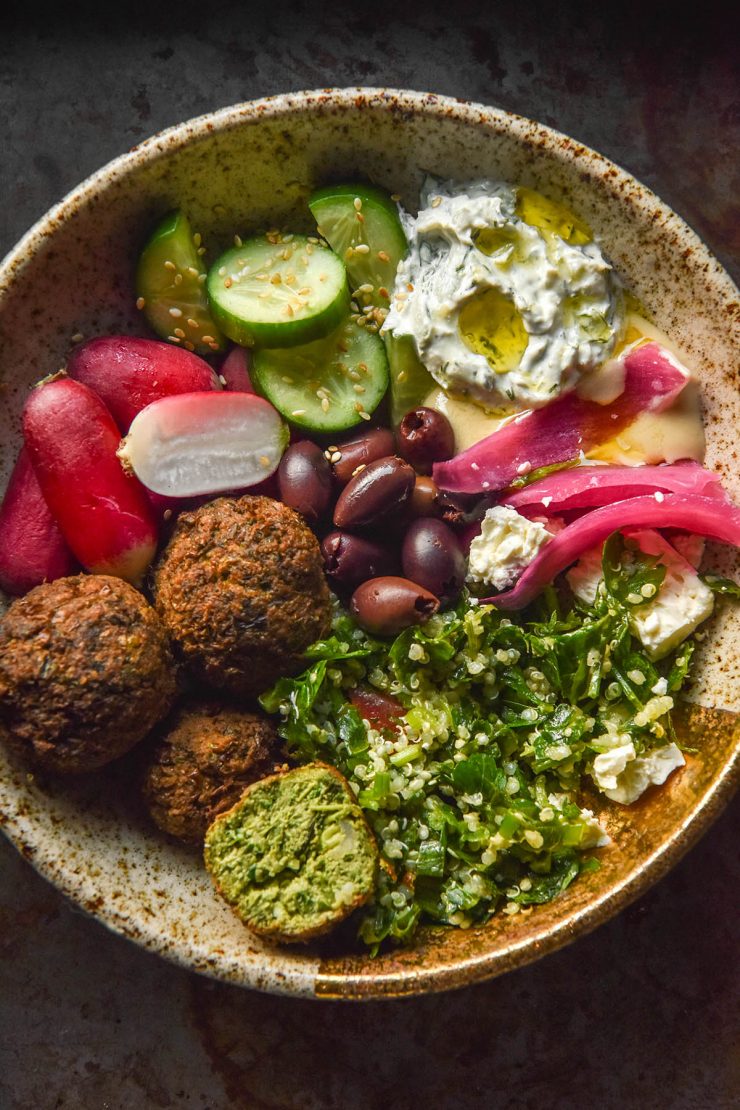
This recipe is a more of a composite recipe. I wanted to write it because it can be tricky to sit down and balance all the FODMAP contents of different ingredients on the fly. A falafel bowl is not something you’d generally consider to be low FODMAP, but it is something delicious. So, today we’re making low FODMAP falafel bowls.
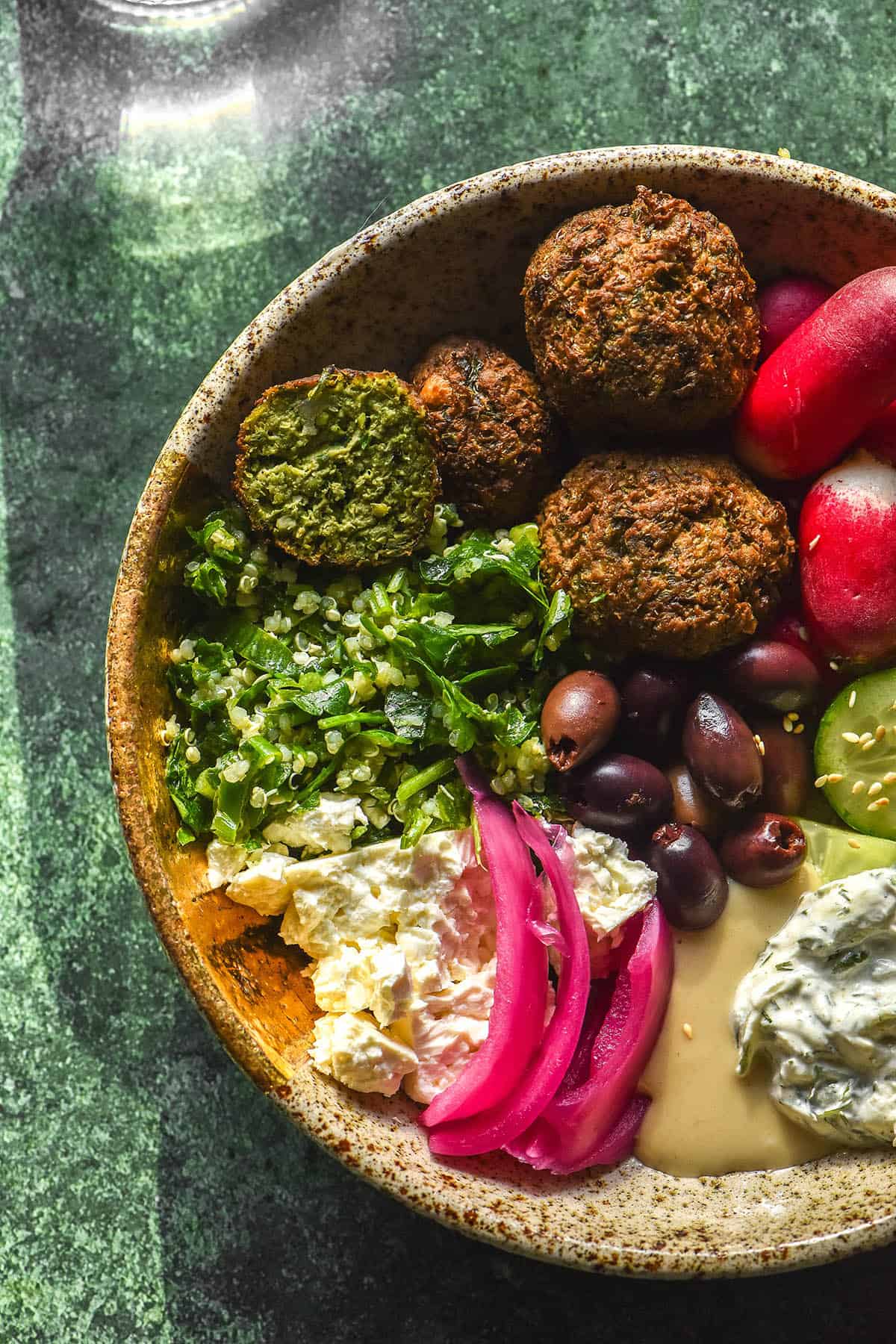
Low FODMAP falafel bowls
These low FODMAP falafel bowls bring together a number of my recipes for a delicious, colourful bowl. You can adjust the ingredients as you see fit in terms of what you prefer and any additional dietaries you have. As they stand, these low FODMAP falafel bowls are gluten free, egg free and vegetarian. They can also easily be made vegan.
Of course, the bowls begin with my low FODMAP falafel recipe. I recommend making the all edamame version here for ease. Using two different legumes with different FODMAPs can muddy the FODMAP waters. Of course, do what works best for you (we’ll get into the specifics below). The falafel are made with buckwheat flour so they are naturally gluten free.
Next, the bowls use a healthy serving of my low FODMAP tabbouleh. The tabbouleh is made with quinoa to remain gluten free and lower FODMAP. While bulgur wheat (which is traditional to tabbouleh) has a low FODMAP threshold, it contains the same FODMAP as the edamame in the falafel (fructan). Eliminating this for FODMAP free quinoa frees up some FODMAP space, if you will, and keeps all the thresholds down.
My newest must have for a falafel bowl (or any bowl)? Low FODMAP pickled onion. Monash has pickled onion listed as low FODMAP in 60-85g serves per person. This makes it a great option for adding some bright and delicious flavour.
On the sauce front, we’re using a tablespoon of tahini and my low FODMAP tzatziki.
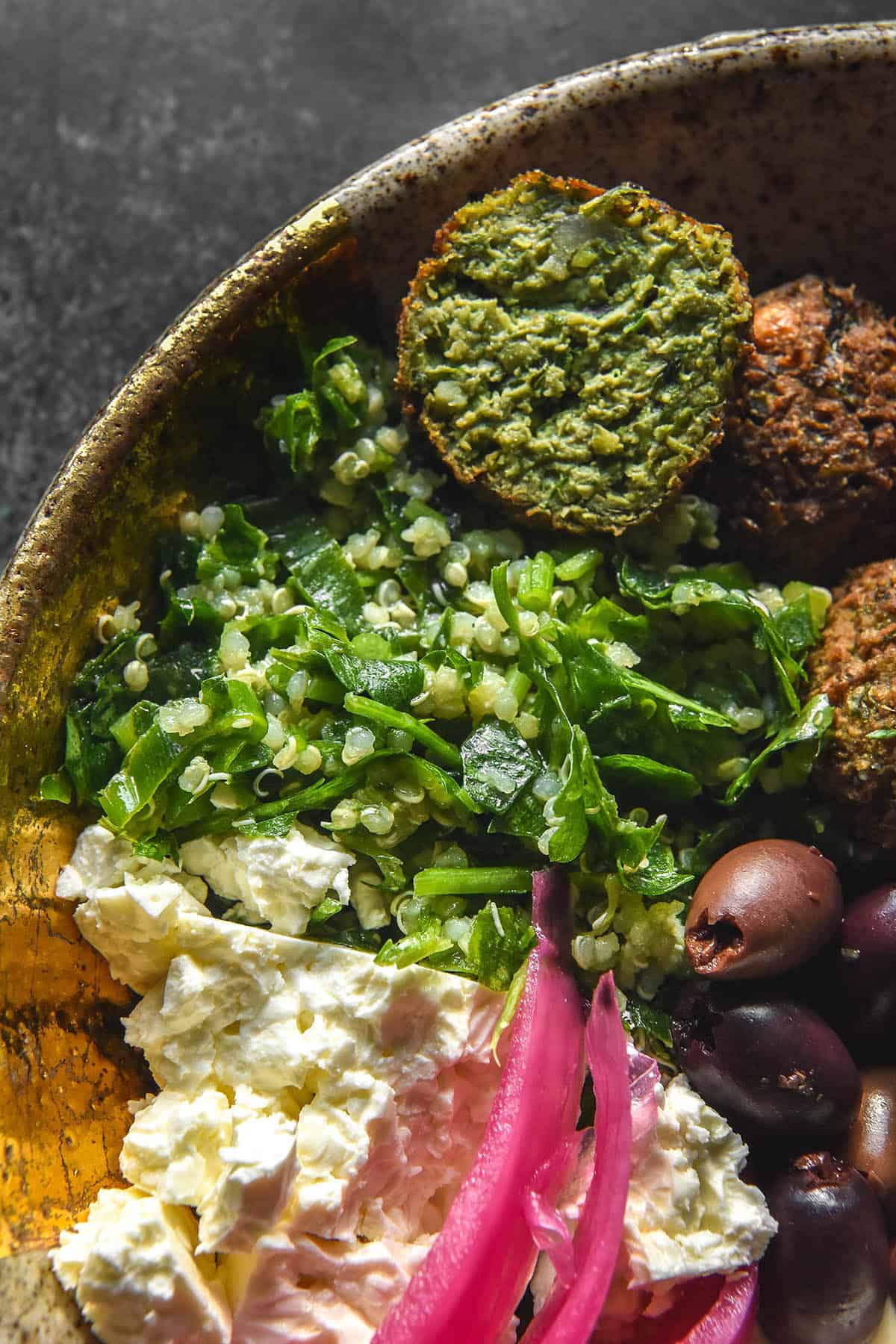
FODMAP ingredients to be aware of
These FODMAP thresholds are current as of June 2025.
The falafel are made with either 1/2 canned chickpeas and 1/2 edamame beans or all edamame beans. I recommend making the all edamame version here – it makes everything less confusing.
Edamame is low FODMAP in 75g serves. Monash recently changed this from 90g serves per person. However, it doesn’t contain moderate amounts of fructans until it exceeds servings of 195g. This gives you a good amount of wiggle room in terms of the fructan content of your bowls.
Tomatoes and cucumbers (as well as potentially pickled onion) contain fructose. There is tomato in the tabbouleh and cucumber in the tzatziki as well as a small amount served in the bowl. Tomatoes have a threshold of 65g tomato per serve. Lebanese cucumbers have a threshold of 75g per serve. They contain moderate amounts of fructose in serves exceeding 97g. You can have a bit more cucumber if you use Continental cucumbers, as they don’t contain moderate fructose until they exceed 132g servings.
Pickled onion (made from large onions as opposed to cocktail onions) is low FODMAP in 60g serves. In 85g serves, it contains moderate amounts of fructan.
Tzatziki uses Greek yoghurt or coconut yoghurt as a vegan alternative. To ensure the tzatziki remains low FODMAP, choose lactose free yoghurt (if you are on the elimination diet or have lactose issues).
Tahini is low FODMAP in 30g (2 tablespoon) serves. However, it doesn’t become moderate for GOS until it exceeds 184g per serve (for hulled tahini) or 104g for unhulled tahini.
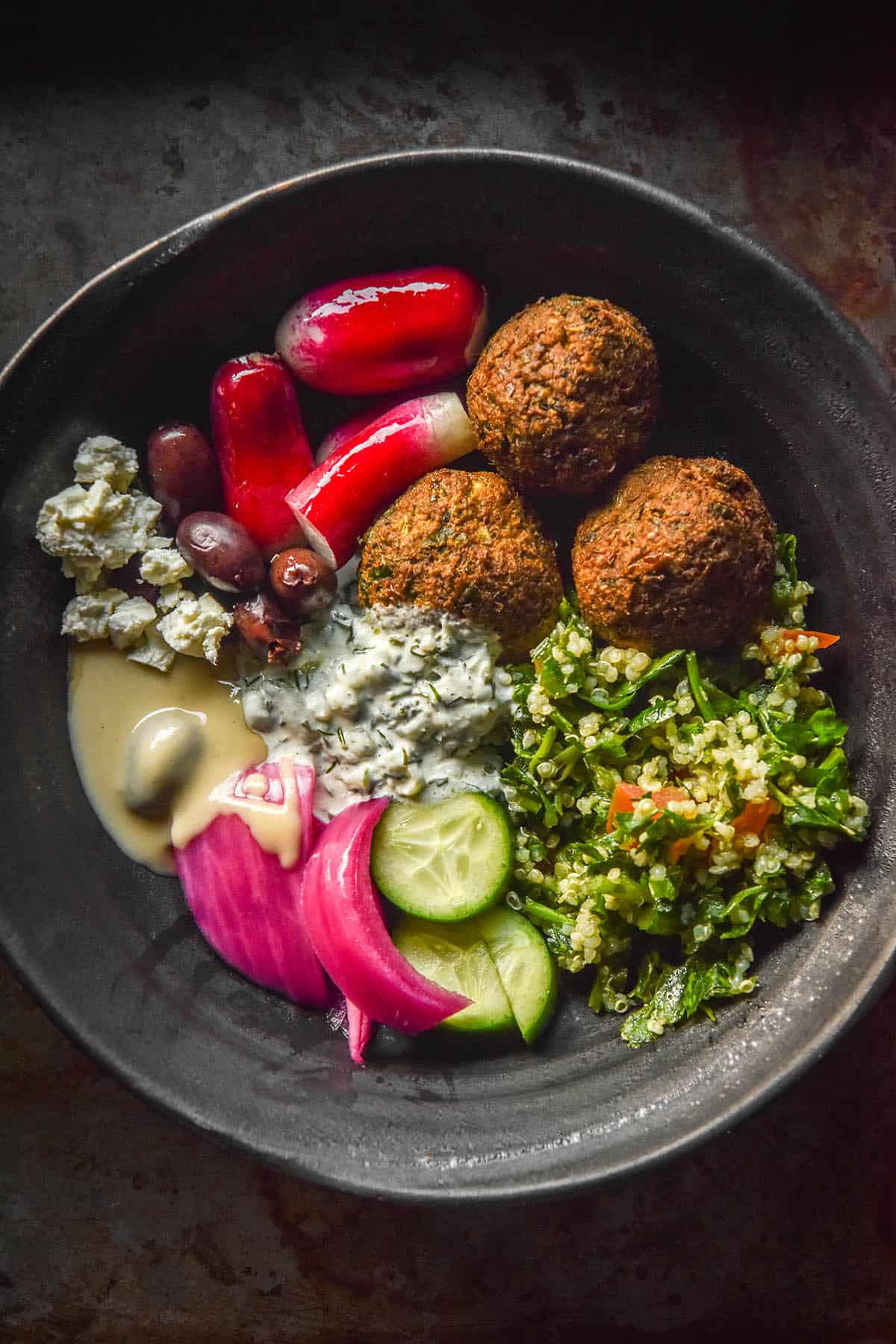
Ingredients in these low FODMAP falafel bowls that are naturally low FODMAP
Feta is low FODMAP and remains so in serves of up to 500g. This is great for everyone, lactose averse or not.
Radishes are low FODMAP in serves of up to 500g. They make a crunchy and delicious addition to your low FODMAP falafel bowl. They also replace from the vibrancy from omitting slices of tomato.
Briny olives (as opposed to marinated ones, which often contain garlic) are low FODMAP in serves of up to 500g.
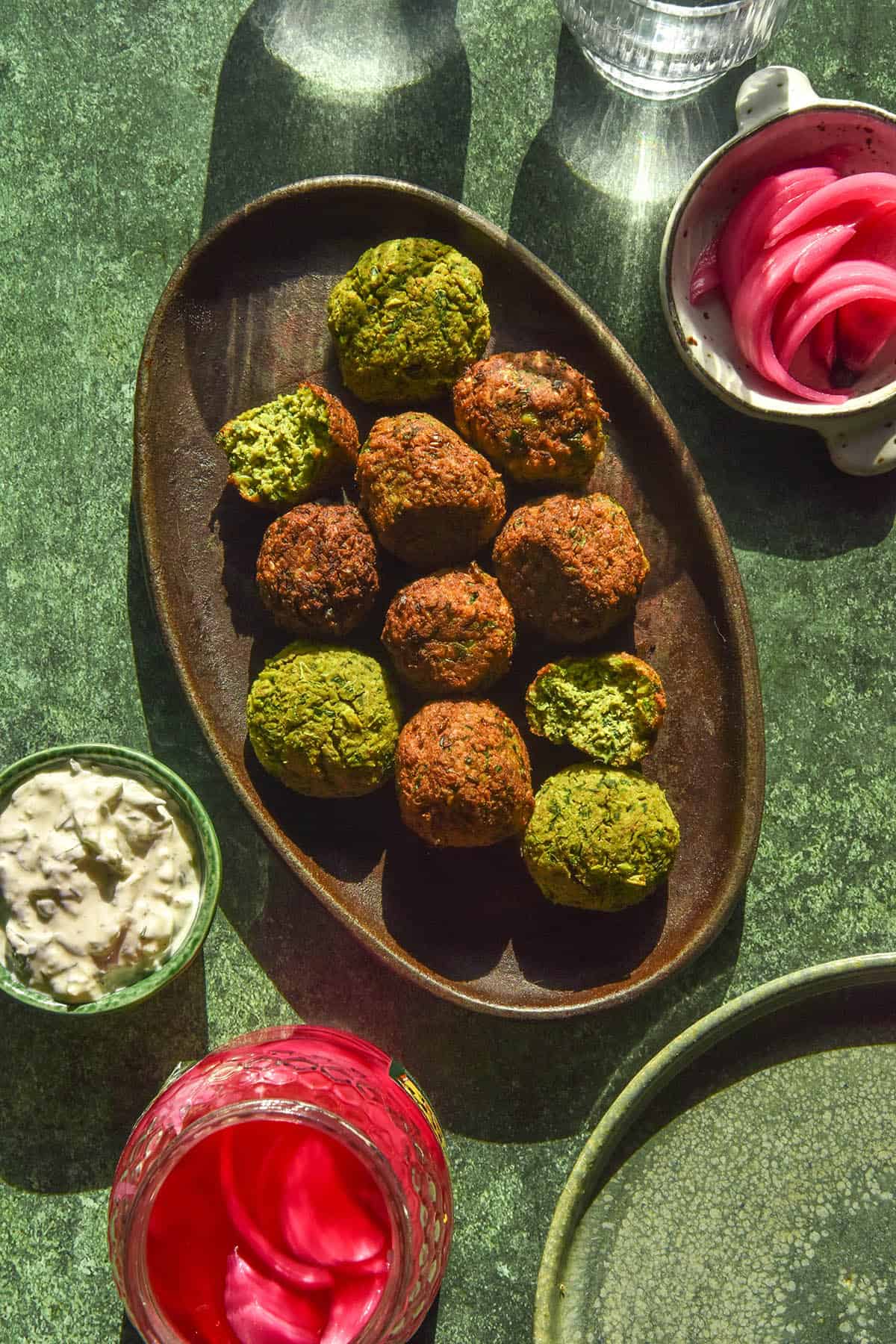
Ways to lower the FODMAP content of these falafel bowls
- Use lactose free Greek yoghurt in the tzatziki. You can also experiment with adding more dill and omitting the cucumber to eliminate the fructose content from the cucumbers.
- Omit the tomatoes from the tabbouleh. Controversial opinion: unless you are using the most beautiful sweet tomatoes of your life, they don’t add much to tabbouleh (sorry).
- I don’t recommend leaving off the pickled onion or leaving the pickled garlic out of the tzatziki. I think those are both integral.
- I think you can, however, leave the optional pickled garlic out of the falafel. They have plenty of flavour without it and the garlic flavour can come from the tzatziki instead. You can also save a little bit of fructose by leaving the spring onion out of the falafel.

More low FODMAP dinner recipes
- Low FODMAP sticky ginger tofu bowls
- Low FODMAP shredded tofu tacos
- Low FODMAP spring roll filling (which can be used in rice paper rolls or as a standalone stir fry)
- Low FODMAP peanut butter tofu
- Low FODMAP vegetable tagine with quinoa
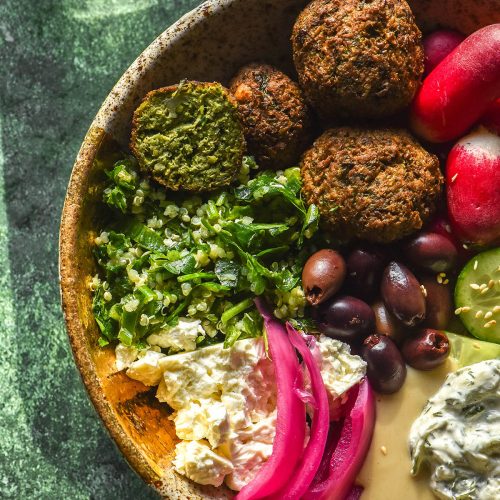
Low FODMAP falafel bowls
Ingredients
- 1 batch low FODMAP falafel (recipe linked in notes)
- 8-10 tablespoons* low FODMAP tzatziki (recipe linked in notes)
- 1 batch low FODMAP tabbouleh (recipe linked in notes)
- 80g+ low FODMAP pickled red onion (recipe linked in notes)
- Radishes, washed and sliced (unlimited)
- 100g Lebanese cucumber, sliced
- 4 tablespoons* tahini
- briny olives, to your tastes (unlimited)
- Greek feta, to your tastes (unlimited)
- Lemon juice, to serve (optional)
- Olive oil, to serve (optional)
Instructions
- Prepare the falafel, tzatziki, tabbouleh and pickled red onions as per the respective recipes. You can heat the falafel prior to serving if you have made them ahead of time (either on the stove, in the oven or in the microwave).
- Arrange the ingredients in 4 bowls: 2-3 falafel per bowl, 2-3 tablespoons tzatziki per bowl, tabbouleh divided by 4 bowls and 20g+ pickled onion per bowl.
- Add an unlimited amount of radishes to the bowls along with 25g cucumber per bowl (more, pending your fructose tolerance). Finish with a tablespoon each tahini and the olives and feta.
- You can serve with a drizzle of good quality olive oil and a squeeze of lemon juice, or just as is.
Notes
- Recipe for low FODMAP falafel can be found here.
- Recipe for low FODMAP tzatziki can be found here.
- Recipe for low FODMAP gluten free tabbouleh can be found here.
- Recipe for low FODMAP pickled red onion can be found here.
- Extensive FODMAP notes are in the body of the post.

No Comments